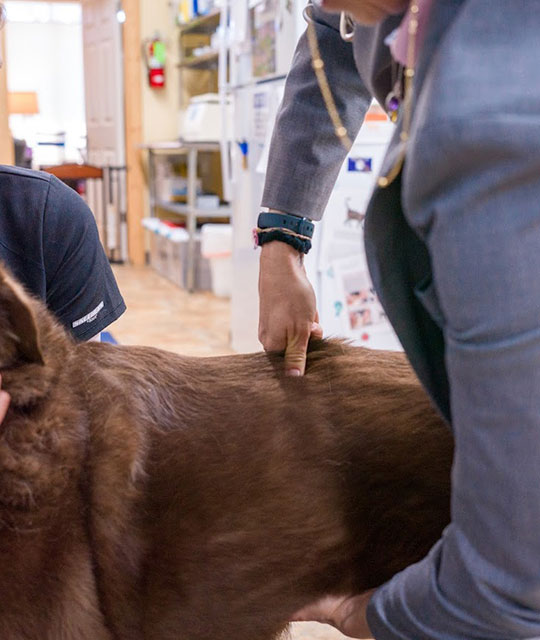
When part of the body is not moving normally, scar tissue and inflammation can develop, further reducing movement and resulting in pain. Veterinary spinal manipulation uses gentle palpation of the joints to identify areas of reduced motion, also referred to as restrictions. These restrictions can be due to scar tissue forming between joints (adhesions), trapped joint membranes (synovial folds), or mild subluxations. A certified provider uses a high velocity/low amplitude thrust at a specific angle over a specific joint to break down adhesions, free trapped joint membranes, or help return joints to their most functional angle. This returns the joint to a normal range of motion that is no longer painful to the animal.
How Spinal Adjustments Support Overall Health
When an animal is in pain, we know that discomfort can have a ripple effect on their entire body — including the immune system. Pain triggers the release of stress hormones (like cortisol), which can suppress immune function over time. By restoring normal joint mobility and reducing pain through targeted spinal adjustments, we help reduce this stress response and support whole-body wellness.
Every animal responds differently to this therapy. That’s why we tailor spinal manipulation sessions based on your pet’s mobility, sensitivity, and overall health. This therapy may be integrated with other treatments like laser therapy or acupuncture for a more comprehensive approach to healing.
Frequency of Adjustments
The frequency of spinal adjustments, depends on the cause of the restriction and subsequent pain:
- If the issue has been present for weeks, months, or years, multiple adjustments over a period of weeks may be needed to return the joint to full range of motion.
- Sometimes, owners may see obvious improvement in their animal’s discomfort after just one treatment.
- Prevent the development of adhesions
- Release any trapped joint tissue
- Maintain full joint range of motion
- Help the immune system work at its fullest to prevent illness

Signs Your Dog or Cat Could Benefit from Spinal Adjustment
- Pain or tenderness along the back
- Behavioral or performance changes
- Difficulty rising or laying down
- Stiffness
- Lameness
- Abnormal sitting position
- Asymmetry of muscle development
- Pain or tenderness along the back
- Behavioral or performance changes
- Difficulty rising or laying down
- Stiffness
- Lameness
- Abnormal sitting position
- Asymmetry of muscle development
If you’ve been searching for a dog chiropractor or cat chiropractic care, VSMT may be the solution your pet needs — without medications or invasive procedures. This therapy is also known as chiropractic in humans and is gaining popularity among pet owners seeking natural approaches to musculoskeletal issues.

Important Notes
Veterinary spinal manipulation therapy, also known as Chiropractic in humans, is not meant to replace conventional veterinary medicine. During the examination of your dog or cat, Dr. Kelley will give recommendations regarding any diagnostics or treatments that may be needed before performing a spinal adjustment. Any additional diagnostics can be performed by your primary veterinarian or at Cashmere Veterinary Clinic if we are your primary veterinary provider.
After every treatment, we will provide records to your primary veterinarian to keep them involved in the care of your pet. Dr. Kelley looks forward to working with your primary veterinarian to help your pet receive the best care possible.
Some pet insurance plans may offer reimbursement for spinal manipulation therapies when prescribed for musculoskeletal or neurologic conditions. If you’re not sure what your plan covers, refer to your policy — and if you don’t currently have pet insurance, visit our website to learn more.




